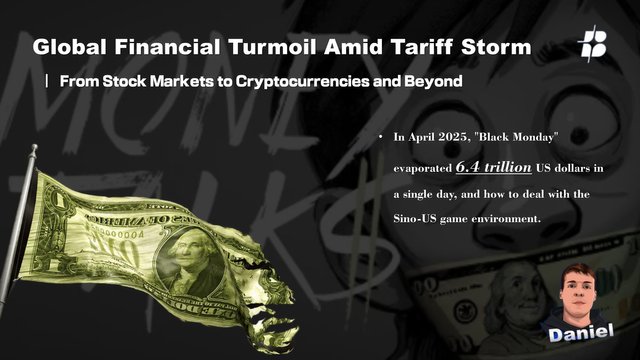Global Financial Turmoil Amid Tariff Storm: From Stock Markets to Cryptocurrencies and Beyond
In April 2025, "Black Monday" evaporated 6.4 trillion US dollars in a single day, and how to deal with the Sino-US game environment.

I. The Trigger: How Tariff Policies Strangle Global Markets
- Policy Shock and Market Plunge
- US Stock Market Crash: On April 3, following Trump's announcement of "reciprocal tariffs," the three major US stock indices plummeted, with the Dow Jones dropping 5.5% and the S&P 500 falling 5.97%. The combined market value of the "Seven Sisters" tech giants shrunk by over $505 billion.
- A-Share Market Follows Suit: On April 7, China's three major A-share indices opened more than 4% lower, with the ChiNext Index diving 6.77%, as panic spread throughout the market.
- Cryptocurrency Crash: Bitcoin fell below $83,000, Ethereum dropped 10%, and MEME coins on the BSC chain saw their values halved.
- Across-the-Board Decline in Global Assets
- Commodity Markets: WTI crude oil fell below $60 per barrel, hitting its lowest level since 2021. Gold's safe-haven appeal proved short-lived, with spot gold prices dipping below $3,000.
- Exchange Rate Volatility: The yen rose 1% due to safe-haven demand, while non-US currencies like the Australian dollar and euro collectively depreciated.
II. Underlying Logic: Trade War 2.0 and Market Repricing
- History Repeating? The Ghost of the Smoot-Hawley Tariff Act
- The 1930 Smoot-Hawley Tariff Act triggered a global trade war, contributing to the Great Depression. Today, Trump's "reciprocal tariffs," covering all trade partners with a rate as high as 49%, significantly increase the risk of global supply chain disruption.
- Inflation Spiral Threat: With 97% of US clothing and footwear reliant on imports, UBS estimates that everyday consumer goods prices could rise by 10%-12%, hitting low-income households the hardest.
- The "Triple Decoupling" in US-China Relations
- Escalating Pressure from Trade-Tech-Finance: Guotai Securities points out that tariffs are just the beginning, with potential follow-ups including tech restrictions (like AI chip export limits) and financial sanctions (delisting of Chinese stocks).
- China's Response Strategy: Huatai Securities analyzes that China's policy toolkit is well-stocked, with reserve requirement ratio cuts, consumption stimulus, and infrastructure investment likely to be the main countermeasures, elevating the importance of domestic demand strategy.
- The "De-risking Paradox" of Cryptocurrency
- Bitcoin's correlation with traditional risk assets (such as the Nasdaq) has risen to 0.5, losing its "digital gold" luster.
- Leverage Liquidation Chain Reaction: High leverage positions (e.g., 20x) in MEME coins on the BSC chain faced mass liquidation after a 5% price fluctuation, exacerbating sell-offs.
III. Trend Forecast: Spotting Structural Opportunities in the Storm
- Short-Term Market Trajectory
- Key Nodes: With tariffs taking effect on April 9 and China's countermeasures landing on April 10, if negotiations don't resume, the US stock market could drop another 5%-10%.
- Cryptocurrency Rebound Catalyst: Should BTC stabilize above $80,000, MEME coins might rebound with community buzz, but regulatory crackdowns (like the Trump family token incident) remain a risk.
- Medium- to Long-Term Asset Allocation Logic
- Safe-Haven Assets: Gold (targeting $3,100), yen, and Treasury ETFs (such as TLT) continue to serve as safe havens for capital.
- Countercyclical Sectors:
- Consumption and Infrastructure: Under China's domestic demand policy push, leading home appliance and building materials firms (like Midea and Anhui Conch Cement) may benefit.
- Tech Self-Reliance: Domestic chips (SMIC) and AI large models (Baidu's Ernie Bot) are poised for valuation recovery with policy support.
- Cryptocurrency Value Reset:
- RWA Sector: Tokenized US Treasuries (e.g., Ondo Finance) and collateralized lending (Maple Finance) offer annual returns exceeding 4%, attracting institutions like Grayscale to increase positions.
- Layer 2 Technology Dividends: Ethereum's Pectra upgrade could spark staking demand, with ARB and OP tokens expected to see a 50% mid-term increase.
IV. Investor Strategy: Defense, Hedging, and Contrarian Layout
- Defensive Moves
- Reduce Exposure to Volatile Assets: Liquidate MEME coins and tech stocks, retaining 20%-30% in cash or stablecoins (USDC, DAI).
- Options Protection: Purchase BTC put options (strike price $75,000) and Nasdaq ETF put options (strike price 10% below current levels).
- Hedging and Arbitrage
- Cross-Market Arbitrage: Go long on gold/short on crude oil (as historical volatility differentials widen to 30%), and long on yen/short on the Australian dollar.
- A/H Share Premium Convergence: Increase positions in undervalued blue-chip Hong Kong stocks (like Tencent and Meituan) to arbitrage capital inflows.
- Contrarian Layout Opportunities
- Bitcoin Dollar-Cost Averaging: Buy in tranches between $76,000 and $82,000, with a long-term target of $180,000 (Galaxy forecast).
- Policy-Beneficiary Stocks: Sectors like environmental protection (carbon neutrality subsidies) and defense (geopolitical tensions) may show resilience against the trend.
Conclusion: Finding Certainty in Uncertainty
The 2025 tariff storm represents both the growing pains of globalization and an opportunity for asset repricing. History has shown that trade protectionism ultimately backfires, while technological revolutions and policy wisdom are the keys to breaking the deadlock. Investors need to abandon the illusion of a "quick victory" and, in defense, capture structural dividends, waiting quietly for dawn in the eye of the storm.